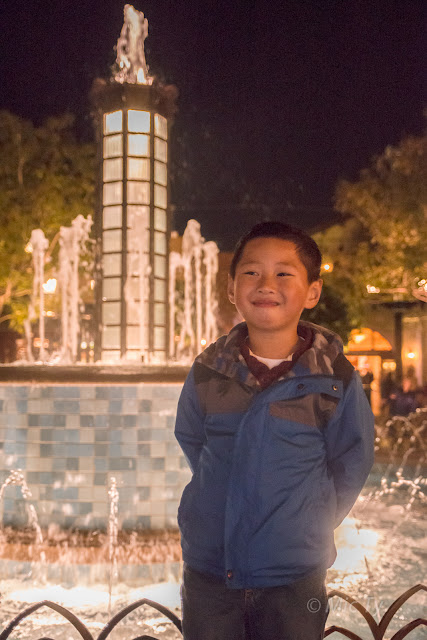 |
| f/4.5, 1/320, ISO 1250 |
Here is a quick portrait I took yesterday. Here is what it looks like without flash:
We were outdoors, with no nearby walls. Hit the jump for the lighting technique I used.
In the shot with flash, the technique I used was to bounce the flash from the ground. Some photographers would not think of lighting the subject from below because the first thing they think of about upside down lighting is the horror-movie look. Well, I hope there's nothing horrific about the portrait above. :)
In this case, the lighting in the portrait with flash looks better to me because the flash added a certain glow to the image. It works because it is similar to the beauty lighting setup used in fashion photos. In beauty lighting, a reflector facing upward is often used to fill in shadows that can otherwise exaggerate wrinkles or sagging skin. It makes the subjects look younger.
Here is a sample (video courtesy of Sean Armenta and FStoppers.com):
Obviously my son doesn't need to look younger, but for better or worse, many people have associated that subtle uplight with the glamour/fashion look, so when I use it, it makes the subject look more 'glamorous'.
The secret to making it work is that the upside down flash must not be the dominant light source. In the beauty lighting example that you saw, the uplight was only from a reflector, which is not a bright light source at all. The key light from the beauty dish is still the dominant light source, and notwithstanding the uplight, the shadow direction is from a light source above the subject, not below.
Similarly, in the shot of my son, the key light is still the open shade. The bounce flash doesn't overpower it. You can see that the shadow below his eyes and his naso-labial fold (the line from the nose to the corner of the mouth) still has a normal downward pointing shadow.
To make sure the flash didn't become dominant, I dialed the TTL flash way down. I dialed it to -3 FEC first, but found that still too strong so I added another -1 FEC (-4 FEC total) by adjusting it in the camera body, which in Nikon is cumulative with the adjustment on the external flash.
Here is another sample:
 |
| No flash. |
 |
| With flash |
In this following shot I feel I overdid it, and in retrospect would have liked to dial down the flash further. But it's here to illustrate an example of what I believe is the tipping point. It starts to look like most of the light is from below the subjects.
This technique works even better when the sun or other light source is providing rim light, and the flash is bounced from the direction opposite from the sun:
Here, the uplight looks very natural because it could have been the sunlight hitting the ground and naturally uplighting the subject.
This technique also works well when there is an existing light source at ground level:
In this case, because of the light in the lower part of the fountain, it is not at all unusual to see some light coming from below the subject.
Sometimes, I also bounce from the ground when there is no better alternative. The light looks a little unnatural but at least it's still soft, and to me it's a significant improvement from bare on-camera direct flash. When I have to do this, I sometimes try to bounce from slightly to my left or right.
RELATED POSTS:
Upside Down Flash
Using Midday Sunlight
12 Alternatives to Bouncing from Ceilings and Walls
Bouncing Light Off the Ground






Nice, Mic. Joe McNally uses this approach a lot, he usually bounce a down-facing speedlight onto a silver/gold/white reflector on the ground as fill. Here did you bounce off a reflector or just bare ground? If it is latter, what kind of surface do you think this method will work on (e.g. metal, brick, wood, grass etc.).
ReplyDeleteHi Xiaoli. Yes I've seen McNally do it in some of his videos. In fact in the related post "Upside Down Flash" that's where I got the inspiration.
DeleteHere however I just bounced off the bare ground (in this case, concrete). I say try it on whatever surface is below you. Some are of course more efficient than others but if you have enough power why not?
As for the color, it will be affected by the surface but I think that makes it look more natural. For example if you bounce off the grass there will be a green tint but that's ok because if sunlight fell on the ground and bounced off it, the same thing would happen.
Best regards,
Mic